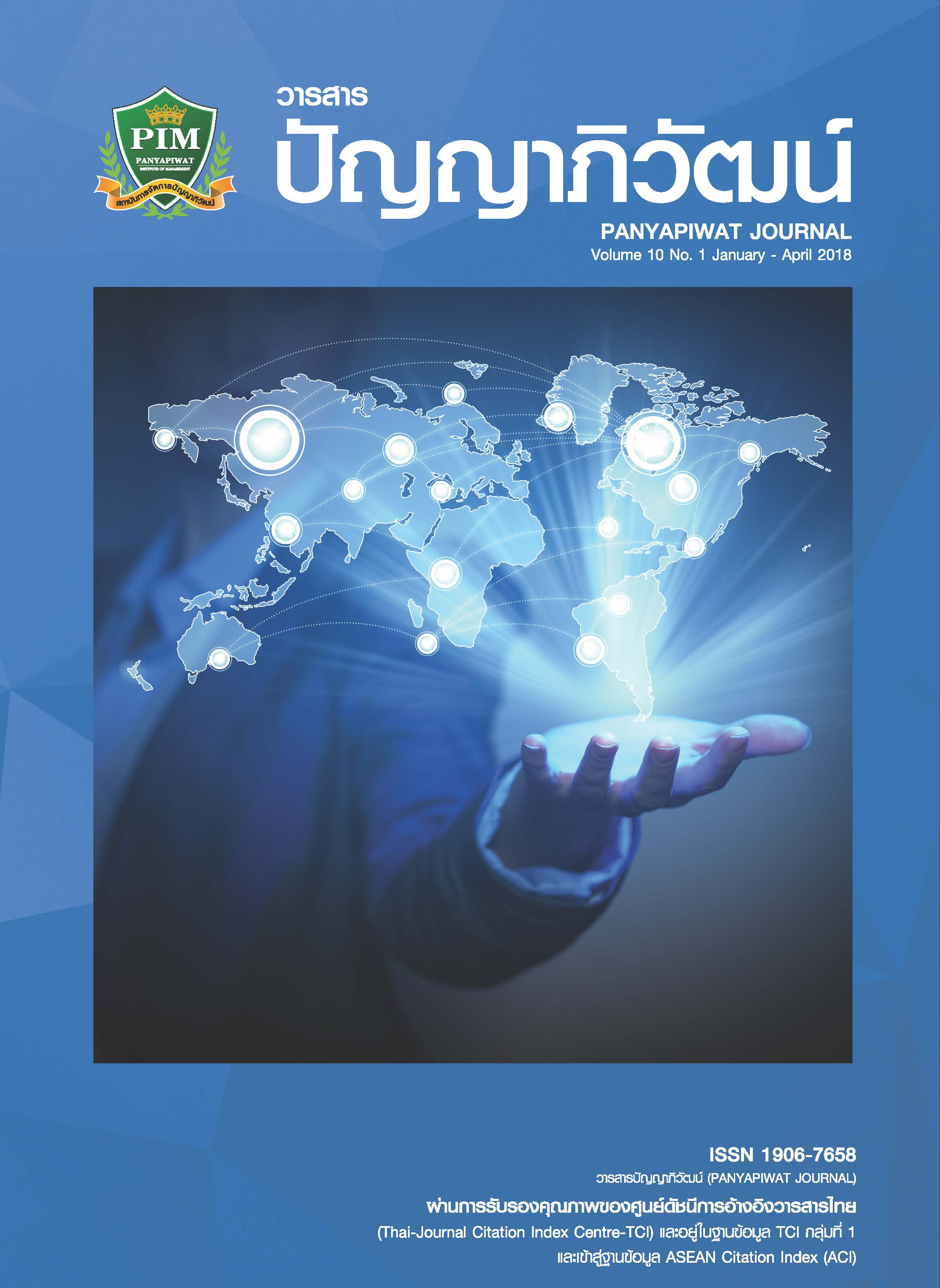CRITICAL SUCCESS FACTORS IN CUSTOMER LOYALTY: CASE STUDY OF INTERNATIONAL FAST FOOD BRAND IN MYANMAR
Main Article Content
บทคัดย่อ
The purpose of this study is to examine the relationship between five dimensions of perceived service quality, brand image and customer satisfaction towards customer loyalty of fast food restaurant in Yangon, Myanmar. The quantitative questionnaires were approached by using linear regression analysis to confirm the results. Survey data were collected from 400 customers who experienced the service of international fast food restaurant in Yangon namely KFC, Mary Brown and Lotteria. Survey data were collected from customers who are visiting in shopping malls namely Myanmar Plaza, Junction City, and Junction Square. Results of the study suggest customer loyalty is most influenced by the “Tangibility” dimension. The finding also shows that brand image is also positively influenced customer satisfaction and loyalty.
วัตถุประสงค์ในการวิจัยครั้งนี้คือ หาความสัมพันธ์จากปัจจัยทั้งห้าด้านเกี่ยวกับการรับรู้คุณภาพบริการ ภาพลักษณ์และความพึงพอใจต่อความภักดีของลูกค้าร้านอาหารฟาสต์ฟูดในย่างกุ้ง ประเทศพม่า การวิจัยครั้งนี้ใช้แบบสอบถามเชิงปริมาณในการศึกษาปัจจัยที่มีผลต่อความภักดีของลูกค้า โดยใช้การวิเคราะห์การถดถอยเชิงเส้น กลุ่มตัวอย่างที่ใช้ในการสำรวจ มีจำนวนทั้งหมด 400 คน ที่มีประสบการณ์ในการรับบริการจากร้านอาหารฟาสต์ฟู้ด 3 แบรนด์ ได้แก่ (1) KFC (2) Mary Brown และ (3) Lotteria ในศูนย์การค้า 3 แห่งในย่างกุ้ง ได้แก่ (1) Myanmar Plaza (2) Junction City และ (3) Junction Square ผลการศึกษาชี้ให้เห็นว่า ความจงรักภักดีของลูกค้าได้รับอิทธิพลมากที่สุดจากการให้บริการที่เป็นรูปธรรม อีกทั้งภาพลักษณ์ของแบรนด์ยังส่งผลทางบวกต่อความพึงพอใจและความภักดีของลูกค้า
Article Details
“ข้าพเจ้าและผู้เขียนร่วม (ถ้ามี) ขอรับรองว่า บทความที่เสนอมานี้ยังไม่เคยได้รับการตีพิมพ์และไม่ได้อยู่ระหว่างกระบวนการพิจารณาลงตีพิมพ์ในวารสารหรือแหล่งเผยแพร่อื่นใด ข้าพเจ้าและผู้เขียนร่วมยอมรับหลักเกณฑ์การพิจารณาต้นฉบับ ทั้งยินยอมให้กองบรรณาธิการมีสิทธิ์พิจารณาและตรวจแก้ต้นฉบับได้ตามที่เห็นสมควร พร้อมนี้ขอมอบลิขสิทธิ์บทความที่ได้รับการตีพิมพ์ให้แก่สถาบันการจัดการปัญญาภิวัฒน์หากมีการฟ้องร้องเรื่องการละเมิดลิขสิทธิ์เกี่ยวกับภาพ กราฟ ข้อความส่วนใดส่วนหนึ่งและ/หรือข้อคิดเห็นที่ปรากฏในบทความข้าพเจ้าและผู้เขียนร่วมยินยอมรับผิดชอบแต่เพียงฝ่ายเดียว”
References
Aaker, D. (1997). Should you take your brand to where the action is? Harvard Business Review, 75(5), 135-143.
Aksoy, L. (2013). How do you measure what you can't define? The current state of loyalty measurement and management. Journal of Service Management, 24(4), 356-381.
Aydin, S .& Ozer, G.(2005). The analysis of antecedents of customer loyalty in the Turkish mobile telecommunication market. European Journal of Marketing, 38(7/8), 910-925.
Ball, L. & Millen, R. (2003). Applying SERVQUAL to Web sites: an exploratory study. The International Journal of Quality and Reliability Management, 20(8), 919-935.
Berezan, O., Raab, C., Yoo, M. & Love, C. (2013). Sustainable hotel practices and nationality: the impact on guest satisfaction and guest intention to return. International Journal of Hospitality Management, 34, 27-233.
Brady, M. & Robertson, C. (2001). Searching for a consensus on the antecedent role of service quality and satisfaction: An exploratory cross national study. Journal of Business Research, 51(1), 53-60.
Cronbach, L. (1951). Coefficient alpha and the interanl structure of tests. Psychometrika, 16(3), 297-334.
Cronin, J. & Taylor, S. (1992). Measuring service quality: A reexamination and extension. Journal of Marketing, 56(3), 55-68.
Dabholkar, P., Shepherd, D. & Thorpe, D. (2000). A comprehensive framework for service quality: An investigation of critical conceptual and measurement issues through a longitudinal study. Journal of Retailing, 76(2), 139-173.
Demirci Orel, F. & Kara, A. (2014). Supermarket self-checkout service quality, customer satisfaction, and loyalty: empirical evidence from an emerging market. Journal of Retailing and Consumer Services, 21(2), 118-129.
Evanschitzky, H., Ramaseshan, B., Woisetschläger, D. M., Richelsen, V., Blut, M. & Backhaus, C. (2012). Consequences of customer loyalty to the loyalty program and to the company. Journal of the Academy of
Marketing Science, 40(5), 625-638.
Garnefeld, I., Helm, S. & Eggert, A. (2011). Walk your talk: an experimental investigation of the relationship between word of mouth and communicators' loyalty. Journal of Service Research, 14(1), 93-107.
Gorla, N. (2011). An Assessment of information systems service quality using SERVQUAL. Database for Advances in Information Systems, 42(3), 46-70.
Harrington, R., Ottenbacher, M., Staggs, A. & Powell, F. (2011). Generation Y consumers: Key restaurant attributes affecting positive and negative experiences. Journal of Hospitality & Tourism Research, 36(4), 431-449.
Jones, T. O. & Sasser, W. E. (1995). Why satisfied customers defect. Harvard Business Review, 73(6), 88-99.
Keller, K L. (1993). Conceptualizing, Measuring, and Managing Customer-Based Brand Equity. Journal of Marketing, 57(1), 1-22.
Kim, Y., Hertzman, J. & Hwang, J. (2010). Assessment of Service Quality in the Fast-Food Restaurant. Journal of Foodservice Business Research, 16(4), 346-359.
Lam, S. K, Ahearne, M., Mullins, R., Hayati, B. & Schillewaert, N. (2013). Exploring the dynamics of antecedents to consumer-brand identification with a new brand. Journal of the Academy of Marketing Science, 41(2), 234-252.
Lee, S. (2004). College student's perception and preference of brand name foodservices in university dining operations. Unpublished master's thesis, Oklahoma State University, Stillwater.
Marzocchi, G., Morandin, G. & Bergami, M. (2013). Brand communities: loyal to the community or the brand? European Journal of Marketing, 47(1/2), 93-114.
Namkung, Y. & Jang, S. (2007). Does food quality really matter in restaurant? Its impact on customer satisfaction and behavioral intentions. Journal of Hospitality & Tourism Research, 31(3), 387-410.
Oliver, R. (1980). A cognitive model of the antecedents and consequences of satisfaction decisions. Journal of Marketing Research, 17(4), 460-9.
Oliver, R. (1981). Measurement and evaluation of satisfaction processes in retail settings. Journal of Retailing, 57(3), 25-48.
Parasuraman, A., Zeithamal, V. A. & Berry, L. L. (1985). A conceptual model of service quality and its implications for future research. Journal of Marketing, 49(4), 41-50.
Pizam, I., Shapoval, V. & Ellis, T. (2016). Customer satisfaction and its measurement in hospitality enterprises: a revisit and update. International Journal of Contemporary Hospitality Management, 28(1), 2-35.
Ramseook-Munhurrun, P. (2012). Perceived service quality in restaurant services. Global Conference on Business and Finance Proceedings, 630-643.
Ryu, K, Han, H. & Jang, S. (2010). The effect of hedonic and utilitarian values on customers' satisfaction and behavioral intention in the fast-casual restaurant industry. International Journal of Contemporary Hospitality Management, 22(3), 416-432.
Szymanski, D. & Henard, D. (2001). Customer satisfaction: a meta-analysis of the empirical evidence. Journal of Academy of Marketing Science, 29(1), 16-35.
Zeithaml, V. (1988). Consumer perceptions on price, quality, and value: a mean-end model and synthesis of evidence. Journal of Marketing, 52(3), 2-22.
Zhao, X., Bai, C. & Hui, Y. (2002). An empirical assessment and application of SERVQUAL in a Mainland Chinese department store. Total Quality Management, 13(2), 241-254.

